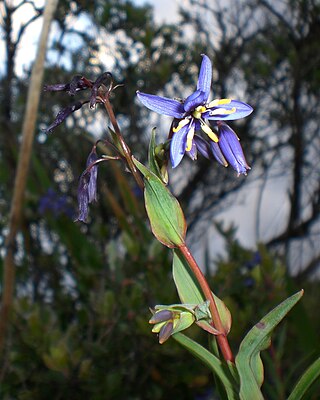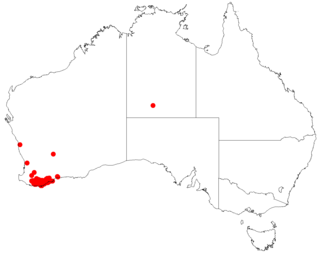
Leucopogon verticillatus, commonly known as tassel flower, is a species of flowering plant in the heath family Ericaceae and is endemic to the southwest of Western Australia. It is an erect, bamboo-like shrub with broadly lance-shaped leaves and pink, tube-shaped flowers crowded along spikes in leaf axils and on the ends of branches.

Stypandra glauca, commonly known as the nodding blue lily, is a flowering plant in the family Asphodelaceae. It is a rhizomatous perennial plant with blue lily-like flowers with yellow stamens. It is widespread across southern areas of Australia.

Andersonia is a genus of mostly small, evergreen shrubs in the family Ericaceae and is endemic to the Southwest Botanical Province in Western Australia.

Leucopogon rubricaulis is a species of flowering plant in the heath family Ericaceae and is endemic to the south of Western Australia. It is an erect, open shrub with narrowly egg-shaped or narrowly elliptic leaves and white, tube-shaped flowers arranged on the ends of branches and in upper leaf axils in groups of four to thirteen.

Pimelea rosea, commonly known as rose banjine, is a species of flowering plant in the family Thymelaeaceae and is endemic to the south-west of Western Australia. It is an erect shrub with narrowly elliptic leaves, and clusters of pale pink to reddish-purple flowers surrounded by 4 egg-shaped involucral bracts.

Patersonia occidentalis, commonly known as purple flag, or long purple-flag, is a species of flowering plant in the family Iridaceae and is endemic to southern Australia. It is a tufted, rhizome-forming perennial with narrow, sharply-pointed, strap-like leaves, egg-shaped, bluish violet sepals and a cylindrical capsule. The Noongar name for the plant is komma.

Leucopogon gracilis is a species of flowering plant in the heath family Ericaceae and is endemic to the south of Western Australia. It is a spindly shrub with wiry branchlets, linear to lance-shaped leaves, and dense spikes of white or pinkish flowers.

Leucopogon alternifolius is a species of flowering plant in the heath family Ericaceae and is endemic to south of Western Australia. It is a low, sprawling shrub with thin branchlets, egg-shaped leaves with a heart-shaped, stem-clasping base, and white or pale pink flowers arranged in up to twenty groups along the flowering branchlets.

Leucopogon apiculatus is a species of flowering plant in the family Ericaceae and is endemic to the south of Western Australia. It is an erect shrub with oblong to elliptic leaves and pink to white tube-shaped flowers.

Leucopogon assimilis is a species of flowering plant in the family Ericaceae and is endemic to the south of Western Australia. It is an erect, slender shrub with linear or lance-shaped leaves and pink to white, tube-shaped flowers.

Andersonia caerulea, commonly known as foxtails, is a species of flowering plant in the family Ericaceae and is endemic to the southwest of Western Australia. It is an erect or spreading to low-lying shrub with variably-shaped leaves and pink and pale blue flowers, sometimes in spike-like groups.

Leucopogon glabellus is a species of flowering plant in the family Ericaceae and is endemic to the south-west of Western Australia. It is an erect, glabrous shrub with slender branchlets, heart-shaped to lance-shaped leaves, and cylindrical spikes of white flowers.

Leucopogon interruptus is a species of flowering plant in the family Ericaceae and is endemic to the southwest of Western Australia. It is a spreading, glabrous shrub with oval to oblong leaves crowded at the ends of branches, and many small, white, tube-shaped flowers that are bearded inside.

Styphelia multiflora is a species of flowering plant in the family Ericaceae and is endemic to the southwest of Western Australia. It is a rigid shrub with crowded, sharply-pointed, linear to lance-shaped leaves, and white, tube-shaped flowers usually in groups in leaf axils.

Leucopogon polystachyus is a species of flowering plant in the heath family Ericaceae and is endemic to the south-west of Western Australia. It is a slender, erect, usually glabrous shrub that typically grows to a height of 0.4–2 m. Its leaves are linear to lance-shaped, 8.5–17 mm (0.33–0.67 in) long with a rigid, sharply-pointed tip on the end. The flowers are borne on the ends of branches or in leaf axils in short, dense spikes with small, egg-shaped bracts and bracteoles about half as long as the sepals. The sepals are about 3.2 mm (0.13 in) long and often pale pink, and the petals are white, about 4 mm (0.16 in) long and joined at the base, forming a tube, the petal lobes longer than the petal tube.

Leucopogon reflexus, commonly known as heart-leaf beard-heath, is a species of flowering plant in the heath family Ericaceae and is endemic to the south-west of Western Australia. It is an erect shrub with small, usually downturned leaves and short, dense spikes of tube-shaped, white flowers.

Leucopogon tamariscinus is a species of flowering plant in the heath family Ericaceae and is endemic to the south of Western Australia. It is an erect shrub with egg-shaped or lance-shaped leaves and white, tube-shaped flowers arranged in dense spikes on the ends of branches.

Andersonia lehmanniana is a species of flowering plant in the family Ericaceae and is endemic to the south-west of Western Australia. It is a shrub with pointed lance-shaped leaves and white, cream-coloured or pink and blue or purple flowers.

Andersonia macranthera is a species of flowering plant in the family Ericaceae and is endemic to the south of Western Australia. It is a low, compact, cushion-like shrub with pointed egg-shaped leaves and white flowers.

Andersonia parvifolia is a species of flowering plant in the family Ericaceae and is endemic to the south of Western Australia. It is a slender, erect shrub with pointed, egg-shaped leaves pressed against the stem and pink or pinkish-blue or pinkish-purple flowers.




















